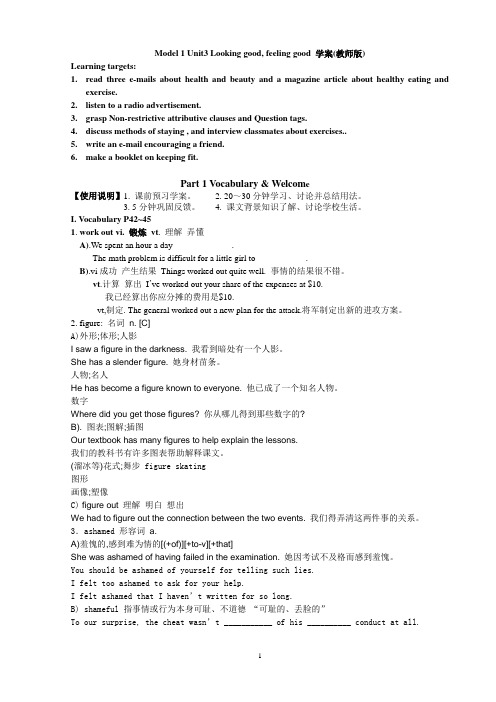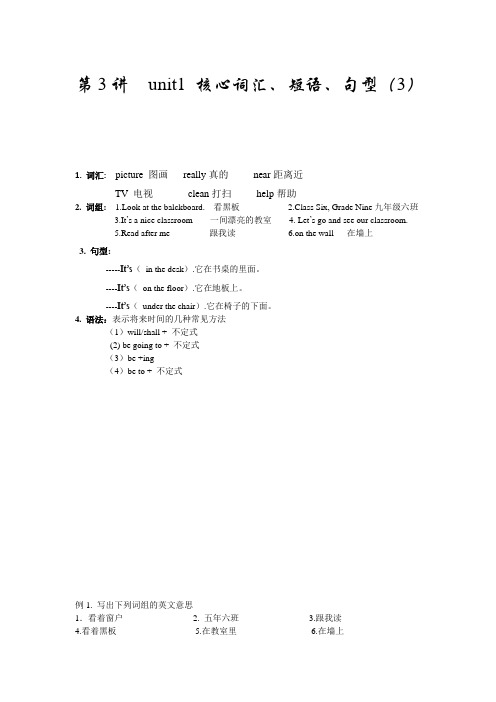小四英语第3讲 unit1 核心词汇短语句型3 教师版 望京张焕静
- 格式:doc
- 大小:178.30 KB
- 文档页数:8

UNIT 3WILL YOU DO ME A FAVOUR?一、核心词汇1.形容词:easy容易的fine好的;健康的kind体贴的,善良的2.动词:borrow借入take拿到;取得3.名词:computer电脑door门window窗户glass玻璃杯word字,词二、了解词汇1.形容词:cold 冷的2.名词:radio收音机light灯drink饮料glasses 眼镜favour恩惠bat球拍3.动词:show展示;给……看close关上pass递,传递feel感觉,觉得have 携带三、核心句型1.— Will you do me a favour, please?能请你帮我个忙吗?— Sure. 当然可以.解读: 这是一个请求别人帮忙的常用口语,也可以说“Will you please do me a favour?”, 后者语气更委婉.2.— Would you please hold these books for me?请你帮我拿着这些书好吗?— No problem.没问题.解读: 这是用来请求帮助的句型,含有说话者一定的希望,期待对方愿意做某事的意味. would you please 意为“请你……”,其后加动词原形.句型结构: Would you please + 动词原形 + 其他?肯定回答: No problem./Sure./OK./Of course.否定回答: I’m sorry +其他.举一反三: — Would you please close the window? 请你关上窗户好吗?— No problem. 没问题.3.— Would you mind opening the door for me?请给我打开门好吗?— Sure. No problem. 当然可以.没问题.解读: 这是礼貌地要求某人做某事的句型及其回答.mind意为“介意;反对”,其后加动名词,一般用于疑问句和否定句.“Would you mind…?”意为“请你……好吗?”句型结构: Would you mind +动名词+其他?回答: Sure. No problem./Sorry.举一反三: — Would you mind turning off the TV?关上电视好吗?— Sure,No problem.当然可以.没问题.4.— Can I borrow your bat?我可以借用一下你的球拍吗?— Yes, of course. 好的,当然可以.解读: 这是can引导的一般疑问句及其肯定回答.can是情态动词,意为“能;可以”,它没有人称和数的变化,不能单独作谓语,只能和后面的动词原形一起构成谓语.“Can I…?”意为“我可以……?”用来表示请求.句型结构: Can + 主语 + 动词原形 + 其他?举一反三: — Can I have a cup of tea?我可以喝杯茶吗?— Yes, of course. 好的,当然可以.四、了解句型1.It’s kind of you. 你太好了.解读: 表示感谢的日常用语,相当于“Thank you(very/so much)./Thanks a lot.”.举一反三: — It’s kind of you. 你太好了.— You’re welcome. 不客气.2.— Would you like a glass of hot water?你想喝杯热水吗?— Yes, please. 好的,谢谢.解读: 询问你想买点或吃(喝)点什么的句型,后常跟名词、名词短语或“to + 动词短语”.举一反三: Would you like some noodles?你想吃点面条吗?I would like to drink some tea. 我想喝点茶.3.I don’t have my ping-pong bat with me. 我没带着我的乒乓球拍.解读: have在此意为“携带”.举一反三: It’s rainy. I don’t have my umbrella with me. 下雨了.我没带雨伞.注意: 当主语是第三人称单数时,have改为has.举一反三: Mike has a new storybook. 迈克有一本新故事书.4.What can I do for you?我能为你做点什么?解读: 这是一个提供帮助的常用语,相当于“Can I help you?”.拓展: 这两句口语可以用于很多场合,如饭店、商场里服务员也经常对顾客这样打招呼.举一反三: — What can I do for you?我可以帮助你吗?(你要买什么?)— I want to buy a hat. 我想买顶帽子.。

Model 1 Unit3 Looking good, feeling good 学案(教师版)Learning targets:1.read three e-mails about health and beauty and a magazine article about healthy eating andexercise.2.listen to a radio advertisement.3.grasp Non-restrictive attributive clauses and Question tags.4.discuss methods of staying , and interview classmates about exercises..5.write an e-mail encouraging a friend.6.make a booklet on keeping fit.Part 1 Vocabulary & Welcom e【使用说明】1. 课前预习学案。
2. 20~30分钟学习、讨论并总结用法。
3. 5分钟巩固反馈。
4. 课文背景知识了解、讨论学校生活。
I. Vocabulary P42~451. work out vi. 锻炼vt. 理解弄懂A).We spent an hour a day _____________.The math problem is difficult for a little girl to ___________.B).vi成功产生结果Things worked out quite well. 事情的结果很不错。
vt.计算算出I’ve worked out your share of the expenses at $10.我已经算出你应分摊的费用是$10.vt,制定. The general worked out a new plan for the attack.将军制定出新的进攻方案。

Module 3 Unit 1 What are they doing?第二课时课时内容Unit 1 What are they doing? Listen and say &Practice课时分析本课时是外研版三年级起点四年级上册第三模块第一单元第二课时。
围绕What are they doing这一话题展开,主要通过对话复习play chess, do taijiquan, row a dragon boat, drink soya milk.及句型What are they doing? They’re…的表达。
引导学生关注身边人正在做的事情,培养学生学习英语的热情,树立学好英语的信心。
第二课时是本单元的巩固,复习了本单元所要掌握的知识。
本课时的的重点是会表达身边人正在做的事情。
本课时包括Listen and say,Practice两个模块。
Listen and say呈现了两幅做不同事情的图片,此板块呈现的是介绍某个人正在做的事情。
此情境是发生在人们熟悉的环境中,学生很容易接受,也因为贴近学生的实际生活,更能激发学生学习的兴趣。
Practice板块是一个综合性的语用活动。
Practice呈现了一幅图片,学生们在做你做我猜的游戏,将句型插入到游戏中,体现了表达正在做某事的短语和意义。
Practice可以让学生练习本课时的句型,学生可以通过这个活动的句型回答,做到学以致用。
本课时是复习课,在设计教学过程时,遵循以学生为主体的原则。
采用听、说、读、写、玩的方法调动全体学生的参与。
通过任务型教学法、合作探究教学法等引导学生自主学习。
课时目标(1)能够听、说、读、写:play chess, do taijiquan, row a dragon boat, drink soya milk.(2)能够运用上述短语句型描述某人正在做的事情。
(3)能够理解句型,What are they doing? They’re…(4)能够听、说、运用句型What are they doing? They’re…(5)引导学生关注自己身边人正在做的事情,培养学生学习英语的热情,树立学好英语的信心。

第3讲unit1 核心词汇、短语、句型(3)1. 词汇: picture 图画really真的near距离近TV 电视clean打扫help帮助2. 词组: 1.Look at the balckboard. 看黑板 2.Class Six, Grade Nine九年级六班3.It’s a nice classroom 一间漂亮的教室4. Let’s go and see our classroom.5.Read after me 跟我读6.on the wall 在墙上3. 句型:-----It’s(in the desk).它在书桌的里面。
----It’s(on the floor).它在地板上。
----It’s(under the chair).它在椅子的下面。
4. 语法:表示将来时间的几种常见方法(1)will/shall + 不定式(2) be going to + 不定式(3)be +ing(4)be to + 不定式例1. 写出下列词组的英文意思1.看着窗户________________2. 五年六班________________3.跟我读____________4.看着黑板__________________5.在教室里_________________6.在墙上___________例2.把下列句子翻译成汉语。
We are going to see a film.We will go and have a look.The train is to leave.Where’s my seat?It’s near the door.I am coming.Look at the picture.例3.( ) We ______ in Grade Four now.A: is B: am C: are( ) Let’s______ and ______ our teacher.A: going/see B: going/seeing C: go/see( ) There __________ a meeting tomorrow afternoon.A. will be going toB. will going to beC. is going to beD. will go to be例4. ( ) Mother ________ me a nice present on my next birthday.A. will givesB. will giveC. givesD. give( ) – Where is the morning paper? – I ________it if for you at once.A. getB. am gettingC. to getD. will getting( ) – Shall I buy a cup of tea for you? –________. (不,不要。

1.excuse me 劳驾2.Where is the new library?新图书馆在哪?3.in that building over there在那边大楼里4.which floor 哪层5.the fifth floor 第五层6.on the left of the stairs 在楼梯左侧7.the third room on the right右侧第三间教室8.not at all 不客气,不用谢9.the teachers’ office 教师办公室10.the art classroom 美术教室11.the computer lab 计算机室12.classroom building 教学楼13.playground 操场14.clinic 医务室15.be looking for Building No.5正寻找五号楼16.Where can I find…? 哪里能找到…17.be nearby 在附近18.be right beside it 恰好在…旁边19.be right behind it 恰好在…后边20.You’re so kind. 你太好了21.the police station 警察局22.in front of the tall building在高楼前边23.behind the drugstore 在药店后边24.the cinema 电影院25.beside the supermarket在超市旁边26.a gas station 加油站27.be not far 不远28.drive on 一直开29.turn left at the first corner第一个拐角左转30.be on y our right 在你右侧31.Can you tell me the way?你能告诉我路吗?32.I see 知道了,明白33.can’t miss it 不会错过34.Car Park 停车场1.劳驾2.新图书馆在哪?3.在那边大楼里4.哪层5.第五层6.在楼梯左侧7.右侧第三间教室8.不客气,不用谢9.教师办公室10.美术教室11.计算机室12.教学楼13.操场14.医务室15.正寻找五号楼16.哪里能找到…17.在附近18.恰好在…旁边19.恰好在…后边20.你太好了21.警察局22.在高楼前边23.在药店后边24.电影院25.在超市旁边26.加油站27.不远28.一直开29.第一个拐角左转30.在你右侧31.你能告诉我路吗?32.知道了,明白33.不会错过34.停车场。

UNIT 3I LIKE JIAOZI BEST一、核心词汇1.名词:banana香蕉potato土豆sweet potato红薯apple苹果juice果汁drink饮料tea茶2.形容词:wonderful令人惊奇的;奇妙的any任何的sweet甜的3.副词:great妙极了sure当然,一定4.介词:before在……以前二、拓展词汇1.名词:chocolate巧克力dinner晚餐;晚饭biscuit饼干pancake薄煎饼jiaozi饺子kitchen厨房fish鱼meat肉noodles面条minute分钟milk牛奶2.短语:milk tea奶茶green tea绿茶black tea红茶三、核心句型1.— Do you want a banana before dinner? 你想在晚餐前吃香蕉吗?— No, thank you.不,谢谢。
解读:这是询问他人是否想要某物的句型。
“Do you want …?你想要……吗?”这个句型是生活中使用频率很高的一句日常用语,它用来征求对方的意见,意思是“你想要……吗?”不管要与不要,都要有礼貌地回答。
举一反三:— Do you want any apples?你想要一些苹果吗?— Yes, please.是的,请来一些。
— Do you want any bread for breakfast?你早饭想吃些面包吗?— No, thank you.不,谢谢。
2.— What’s your favourite food, Lingling? 你最喜欢的食物是什么,玲玲?— It’s jiaozi.是饺子。
解读:这是询问他人最喜欢的食物及其回答的句型。
favourite是形容词,修饰名词或名词短语,意为“特别喜爱的”。
举一反三:— What’s your favourite food?你最喜欢的食物是什么?— It’s fish.是鱼肉。
— What’s your favourite food?你最喜欢的食物是什么?— It’s bread.是面包。
Unit3Look at me!一、核心词汇:face脸,ear耳朵,eye眼睛,nose鼻子,mouth嘴,arm胳膊,head头,hand手,body身体,leg腿,foot脚二、了解词汇:school学校,open打开,close关闭,clap拍,shake抖,stamp跺,Wave挥三、字母:Ee, Ff, Gg, Hh, Ii的认读,规范书写,以及在单词中的发音。
四、核心句型1.— How are you? 你好吗?—I’m fine, thank you.我很好,谢谢你。
/ Very well, thanks.非常好,谢谢。
解读:How are you?的回答还有很多,如Fine, thanks. Very well, thanks.等。
2.—Let’s go to school!我们一起上学吧!/ Let’s make a puppet!我们一起做一个木偶吧!— OK! 好的!/ Great! 太棒了!解读:用于建议一起做某事,let’s 是let us的缩写形式。
可以回答Great!或OK!3.This is my face.这是我的脸。
解读:用于介绍自己身体部位的句型。
拓展:this意为“这”,与它对应的是that,意为“那”。
在表示某物的词前面,通常会有一些词语来表明物品的主人是谁,如:my(我的),your(你的),his(他的),her(她的)。
4. Look at me. 看着我。
五、了解句型1.Clap your hands.拍拍你的手。
解读:hands是hand的复数形式。
2.Stamp your foot.跺跺你的脚。
解读:stamp作动词时,意思是“跺;跺脚”。
feet是foot的复数形式。
3.Wave your arms.挥挥你的胳膊。
4.Shake your legs.抖抖(摇摇)你的腿。
第1讲unit1 核心词汇、短语、句型(1)1. 词汇: window窗户blackboard黑板light电灯fan 电风扇2. 词组: open the door 打开门turn on the light 打开灯3.close the window关窗3. 句型: What’s in the classroom ?---One blackboard ,one TV, many desks and chairs.4. 语法:一般将来时的定义: 将来要发生的动作,计划或打算。
1. 理解一般将来时的定义2. 重要词汇,句型的熟练运用例1. 看图写单词。
答案:light window blackboard fan例2. 填写最佳动词。
1.the door 打开门2. the light 打开灯3. the window关窗答案:open turn on close例3. 看图说话What’s in the classroom?There are in the classroom.答案:some desks and a blackboard例4. On Saturday we’ll_____.A go swimB swimmingC goswimming答案:C例5. Today is Thursday and tomorrow is ____.A FridayB SaturdayC Wednesday答案:A例6. I will____my pictures tomorrow.A takesB takeC taking答案:BA例:选择与图片对应的句子。
()()()()()A. Turn on the light .B. Sweep the floor .C. Open the door.D. Put up the picture.E. Clean the window.答案:C A E D BB例:1.a, picnic, we, will, have, tomorrow ( . )_____________________________________________2.will, she, help, mother, her ( . )______________________________________________3.on, I’ll, my, Thursday, do, homework ( . )______________________________________________4. will, what, you, do ( ? )________________________________________________5.go, to, the, park, will, I, Monday, on ( . )__________________________________________________答案:1. We will have a picnic tomorrow2. She will help her mother3. I will do my my homework on Thursday4.What will you do?5.I will go the park on MondayC读短文,判断正(√)误(×)。
第11讲unit3核心词汇、短语、句型(2)一.核心单词1. wonderful 精彩的2. science 科学3.museum 博物馆4. Mick Mouse 米老鼠5. Disneyland 迪斯尼乐园6. hope 希望7. use 用8. coin 硬币9.toy 玩具10.joy 快乐;高兴二.重点短语1. on weekends 在周末2. collect seashells 收集贝壳3. in Australia 在澳大利亚4. in Russia 在俄罗斯5. go to the ballet 去看芭蕾舞6. come here 来这儿7. buy a toy for the boy 给这个男孩买一个玩具8. jump for joy 高兴地跳起来9. see the new toy 看见新玩具10. in the U.S.A 在美国11. in Canada 在加拿大三.常考句型1.What do you do for fun on weekends? I like to collect seashells.2.Why do you like it? Because it’s cool.四.核心语法like常用动词搭配(一)用作动词:1.like+名词/代词,意为"喜欢某人或某物".例如:Tom likes fish very much.汤姆非常喜欢鱼。
We all like our new teacher. 我们都喜欢新老师。
2.like to do sth. 意为"(偶尔或具体地)喜欢做某事".例如:I like to swim with you today.今天我喜欢和你一起去游泳。
3.like doing sth. 意为"(经常或习惯地)喜欢做某事".例如:He likes singing.他喜欢唱歌。
4.like sb. to do sth.意为"喜欢某人做某事".例如:She likes them to ask questions like this. 她喜欢他们像这样问问题。
第3讲unit1 核心词汇、短语、句型(3)picture 图画really真的near距离近: 词汇1.TV 电视clean打扫help帮助2. 词组: 1.Look at the balckboard. 看黑板 2.Class Six, Grade Nine九年级六班3.It's a nice classroom 一间漂亮的教室4. Let's go and see our classroom.5.Read after me 跟我读6.on the wall 在墙上3. 句型:-----It's(in the desk).它在书桌的里面。
----It's(on the floor).它在地板上。
----It's(under the chair).它在椅子的下面。
表示将来时间的几种常见方法语法:4.(1)will/shall + 不定式(2) be going to + 不定式(3)be +ing(4)be to + 不定式1. 表示将来时间的几种方法2. 重点句型的熟练掌握例1. 写出下列词组的英文意思1.看着窗户________________2. 五年六班________________3.跟我读____________ 4.看着黑板__________________5.在教室里_________________6.在墙上___________ 答案:look at the window;class 6,Grade 5; read after me; look at the blackboard;in the classroom; on the wall例2.把下列句子翻译成汉语。
We are going to see a film.We will go and have a look.The train is to leave.Where's my seat?It's near the door.I am coming.Look at the picture.答案:我们要去看电影;我们走,去看看;火车就要开了;我的座位在哪里;在门附近;我来了;看这幅画。
例3.( ) We ______ in Grade Four now.A: is B: am C: are( ) Let's______ and ______ our teacher.A: going/see B: going/seeing C: go/see( ) There __________ a meeting tomorrow afternoon.A. will be going toB. will going to beC. is going to beD. will go to be答案:C C C例4. ( ) Mother ________ me a nice present on my next birthday.A. will givesB. will giveC. givesD. giveI ________it if for you at once.–Where is the morning paper? –) (A. getB. am gettingC. to getD. will getting( ) –Shall I buy a cup of tea for you? –________. (不,不要。
)A. No, you won't.B. No, you aren't.C. No, please don't.D. No, please. 答案:B B A例5.( ) ________ a concert next Saturday?A. There will beB. Will there beC. There can beD. There are( ) If they come, we ________ a meeting.A. haveB. will haveC. hadD. would have( )Charlie ________ here next month.A. isn't workingB. doesn't workingC. isn't going to workingD. won't work 答案: B B DA例:单项选择。
()1.Mike : Nice to meet you. John: _____________.(A) Nice to meet you. (B) Good morning.()2. Sarah: What's in the classroom? Wu Yifan:_________.(A) A board,tow lights. (B) It's nice and clean.()3. Chen Jie :Let me clean the board. Amy: _____________.(A)OK. (B) Hello.()4.教室里面有什么?(A)What's in the classroom ? (B)What's on the board?()5.我们有一间新教室。
(A)I have a pen. (B)We have a new classroom.)在门旁边_____________.( 6. Where's my seat? )(.(A)It's near the door. (B)It's near the desk.()7. Good morning! ______________!(A)Good afternoon. (B)Good morning.()8. Hello! ______!(A) Nice to meet you. (B) Hello.( )9. How old are you ? _______.(A) I'm 10. (B) I'm fine.( )10.让我们一起擦玻璃吧!(A)Let's clean the window. (B) Let me clean the board.答案:A A A A B A B B A AB例:翻译句子:1、我打算明天和朋友去野炊。
I_____ _______ _________ have a picnic with my friends.I ________ have a picnic with my friends.2、下个星期一你打算去干嘛? 我想去打篮球。
What ________ ________ _________ _________ _________ next Monday?I _______ ______ _____ play basketball.What _________ you do next Monday? I ________ play basketball.3、你妈妈这个周末去购物吗?是,她要去买一些水果。
_____ your mother _______ ________ go shopping this ___________?Yes, she _________. She ______ ________ __________ buy some fruit.4、你们打算什么时候见面。
What time _______ you _________ __________ meet?答案:1. am going to;will 2. are you going to do, am going to, will, will3. Is, going to, weekend, will, is going to4. are, going toC阅读理解,选择最佳选项。
This is my room. Near the window there is a desk. I often do my homework at it. You can see some books, a ruler, a pen and some flowers in the vase(花瓶). On the wall near the desk there is a picture of a cat. There is a clock on my bed . I can put my football under my bed. There is a chair near the desk . I sit there and I can see the trees and the flowers outside(外面) .( )1. What can you see on my desk?A. Some booksB. Some flowers.C. A ruler and a pen.D. A, B and C( )2. Where is the picture? It's _________ .A. on the deskB. on the wallC. above the end of the bedD. under the bed( )3. What's under the bed?A. A ruler.B. A football.C. A cat.D. A clock.( )4. Are there any trees outside(外面)?A. Yes , they are.B. Yes, there are.C. No, they aren't.D. No, there aren't.( )5. The clock is ____ the bed .A near B. in C. on D. behind答案:D B B A C(2)Hello, my name is yang jun. Look, this is my school. There are many flowers and trees in it.I like my school. I'm in class two, grade five. There are forty-one students in my class. Look at my classroom. It's big and bright. you can see a computer on the teacher's desk. And there's a TV nearthe blackboard. On the wall, there are some nice pictures. I like them very much.Welcome to my school.阅读短文,判断正(t)误(f)。